Exactly How to Spend 2 Days in Seattle: A Complete Guide
Seattle is a city that seems to be in a constant state of change. Over the past decade or so, it has seen a rapid rise up the list of American cities to both visit and live in thanks to the thriving cultural scene (it’s the hub of music and theater in the Pacific Northwest), eclectic food and drink scene, and natural beauty surrounding the city.
Growing up in the Seattle area, I wasn’t really aware of just how incredible Seattle and the area surrounding it really are. I mean, I had never been to ANY of the three national parks in Washington State until I was in my 30’s.
Today, after spending more time in and around Seattle as a functioning adult and having more perspective after years of traveling around the world, I think Seattle is a world-class city (and I also think the price to live in Seattle reflects that now).
It’s on the water, has access to the mountains within 90 minutes, attracts a wide range of different types of people (which means it has a great food and drink scene), and has the best events calendar of any city in the Pacific Northwest.
Does it have its problems? Definitely. But every city does. And it’s hard to not be in love with Seattle on a sunny summer afternoon when Mount Rainier is out (a common barometer for a good weather day) and the city comes alive with people out and about soaking up the precious sun.
Seattle is an great city to explore, though two days is not nearly enough to do, see, and eat everything the city has to offer. We’re going to do our best to help you figure out EXACTLY what to do, see, eat, and drink over two days to make you fall in love with Seattle like we have.
In this guide to spending 2 days in Seattle, we’re going to help you plan an amazing trip to Seattle and help you get a good dose of what makes Seattle so special.
Over the course of a couple days, you’ll cover the main attractions, get a taste of the food and drink scene, the natural beauty surrounding the city, and the amazing neighborhoods you’ll find throughout Seattle that locals love.
Plus, we’ll give you some of the crucial logistics – like where to stay and how to get around – to help make your trip a breeze.
Sound good to you? Let’s get into it (almost).
Why am I the right person to craft a guide to Seattle, you ask? Seattle holds a special place in my heart. Midway through 4th grade, my family moved from Northern California to Bellevue, and I spent the next 15+ years in the great Pacific Northwest, including time living and working in the city.
We recently moved to Portland, and find ourselves visiting friends and family in Seattle several times a year thanks to the short drive between the cities.
I’ve done everything on this list, and have taken countless visiting friends and family on some variation of this itinerary.
I’m pretty sure you’re going to love it.
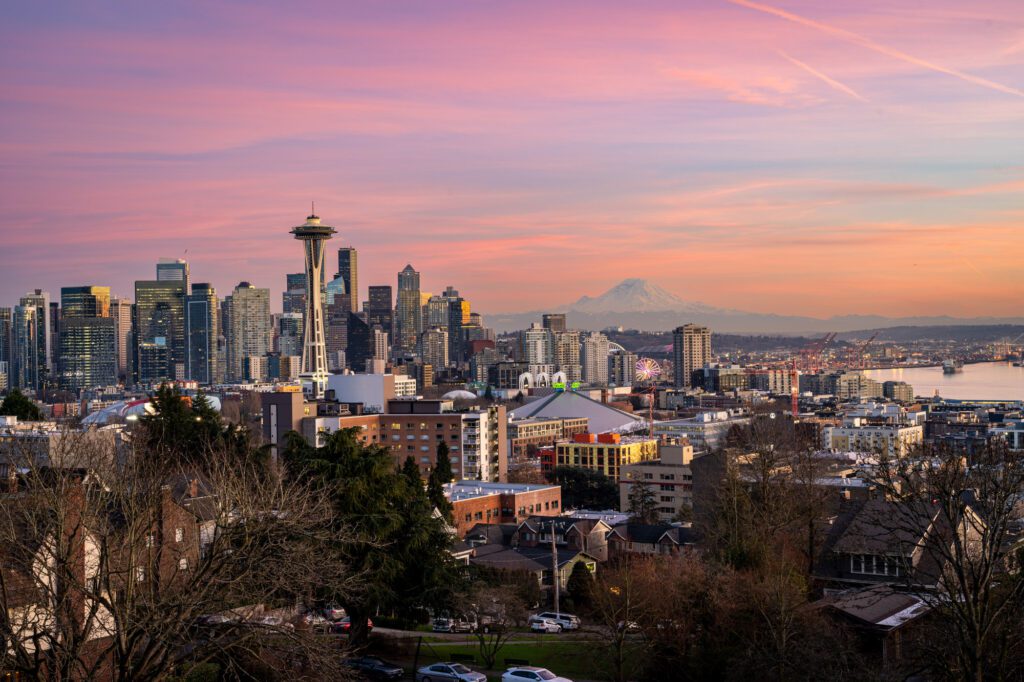
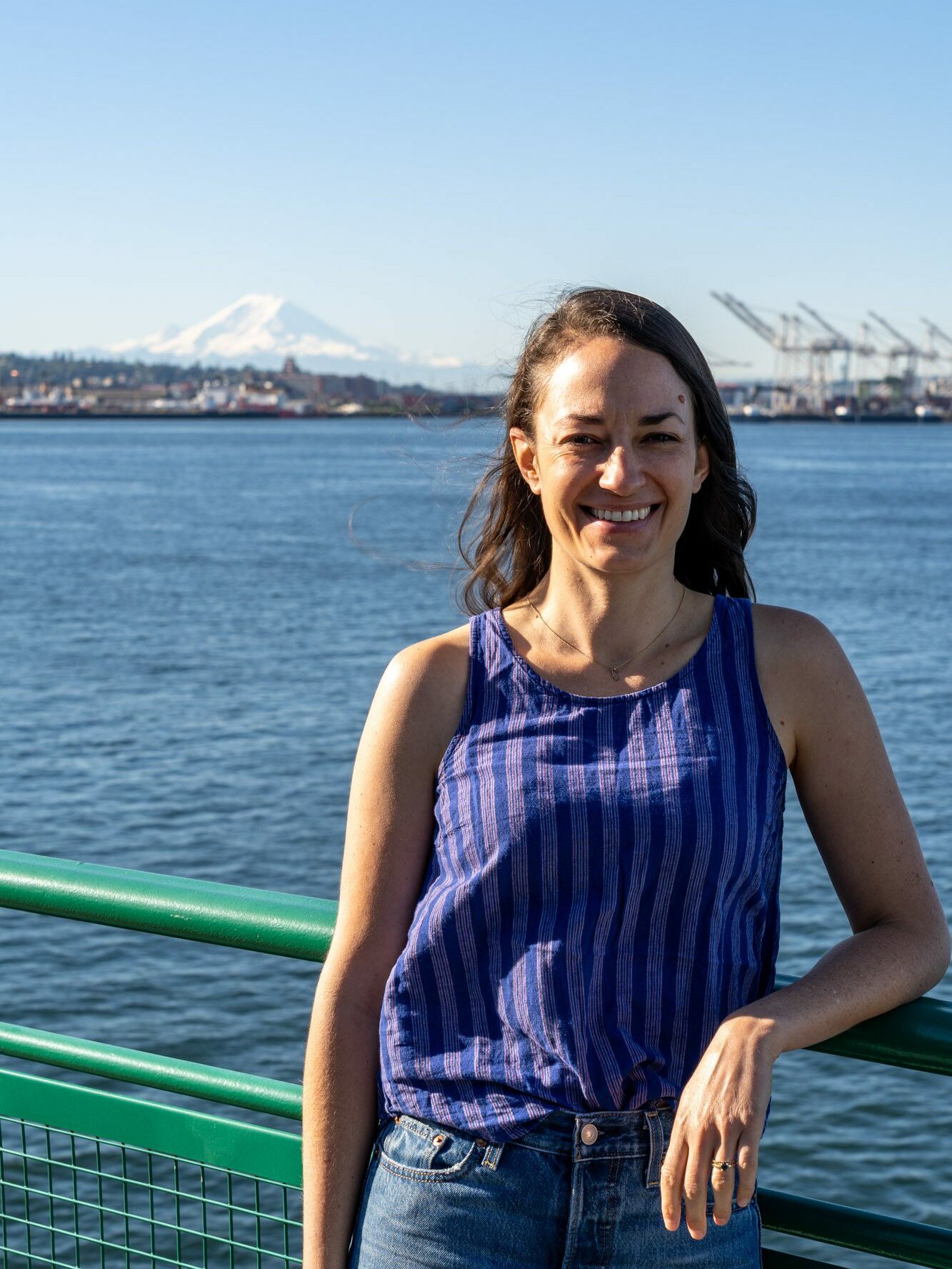

Disclaimer: Some of the links below are affiliate links, which means that if you click on one and purchase something, I make a small portion of the sale at no additional cost to you. It goes without saying that I would never recommend something I wouldn’t use or do myself.
Where to Stay in Seattle
Since you’ll only be in Seattle for a couple of days, you’re going to want to stay in a central area.
We’d strongly urge you to stay in Seattle’s Downtown Core – which we think of as Downtown, Belltown, South Lake Union, and Capitol Hill – for two reasons.
First, it’s the most convenient place to stay in terms of being within 10-15 minutes of basically every single place on the itinerary below, either on foot or by tapping into Seattle’s handy public transportation network.
Second, it’s the easiest to get to from the airport thanks to the Light Rail (more on that in the sections on getting to Seattle and getting around Seattle, which you’ll find below).
Our other favorite neighborhoods – Fremont and Ballard – are a bit far out for spending two days in the city, but are definitely worth visiting.
PS: We have an entire guide dedicated to helping you find the perfect place to stay in Seattle. For more detail on each of these areas, you’ll want to head there.
If you want a good blend of location and vibes/food and drinks, stay in Belltown.

Belltown is immediately adjacent to Downtown Seattle, which means it has a very urban feel. Tall buildings, lots of noise, people everywhere – you get the idea.
It is about as central as you can be to places like Pike Place Market (literally a few minutes away at most), and is packed with some of the best food and drinks in Seattle.
We’ve stayed at the Ace Hotel in Seattle before, which is a surprisingly good value, and liked it.
Hôtel Ändra, a Scandinavian-inspired boutique hotel with an excellent cozy fireplace on the ground floor, is another great option in Belltown.
If you want to be as central as it gets, stay in Downtown Seattle.
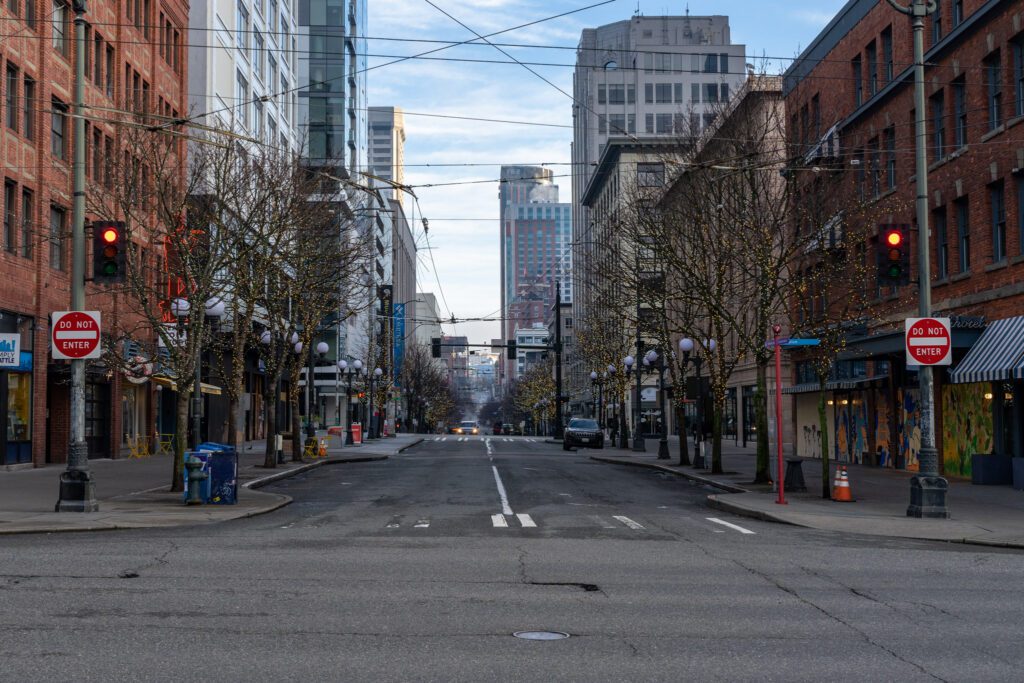
Ideally on the northern end that borders Belltown, near Pike Place Market (we would avoid the area near Pioneer Square).
If you stay in Downtown Seattle, you’ll be within five minutes of Pike Place Market, and walking distance to both Seattle Center and the Light Rail, which will take you further afield (and to the airport).
The State Hotel is on our list for a future trip – we’re suckers for subway tile in the bathroom, and you can’t beat the location a block away from Pike Place Market (or the rooftop with views of Elliott Bay).
If you want to be in a neighborhood packed with good food and drinks, stay in South Lake Union.
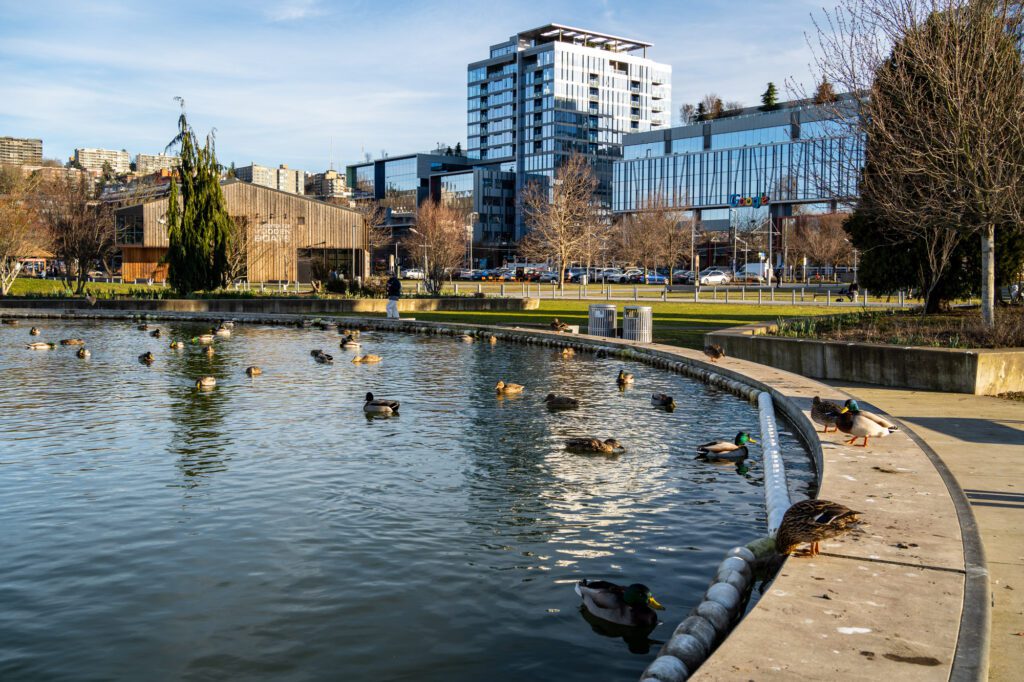
Just north of Belltown is South Lake Union, which is, as you might guess, at the south end of Lake Union.
On the plus side, it’s central, just a few blocks from Seattle Center and the Space Needle. On the… opportunities side, it’s Amazon central.
South Lake Union was literally built by Amazon – all of those tall buildings? Amazon.
We have personally stayed at the CitizenM in South Lake Union, and highly, highly recommend it! It was our first CitizenM experience, and we’ve now stayed in three of their hotels around the world in the past couple of years.
It’s an excellent value, and more traditional hotels should take notes on the modern, streamlined experience. Seriously, we LOVE CitizenM (read about why in our CitizenM Seattle write up).
Getting to Seattle
Seattle-Tacoma International Airport (SEA) – “SeaTac” for short – is the best option to fly into.
It has the most flight options, and it’s well connected to the city with the nifty Light Rail system, which will get you into Downtown Seattle from the airport in about 45 minutes for just $3.
For reference, because there’s a ton of traffic on that route, it could take you 90 minutes in a Lyft to travel that distance.
Getting Around Seattle
In general, we’d spend most of your time in Seattle walking, if you are willing and able. The downtown core – Downtown Seattle, Belltown, South Lake Union, and Capitol Hill – is all fairly compact and walkable.
For those times where you want to go a bit further – like to Fremont or Ballard – you can either take public transportation or a rideshare.
In this section, we’ll cover all of those different modes of transportation (except walking, which seems pretty self-explanatory).
Do You Need to Rent a Car in Seattle?
Let’s start with whether or not you need to rent a car.
For a two day trip to Seattle, we would not recommend renting a car.
The reason? With two days, we’d recommend spending all of your time within Seattle’s city limits, which means you’ll be covered by some combination of Light Rail, buses, and rideshare apps.
If you rent a car, you’ll have to worry about parking it. Which is not a huge deal in most places, although places like Ballard and Capitol Hill can be a little bit of a nightmare.
We think you’ll find that your rental car will spend most of its time parked in a hotel garage, which will cost you somewhere in the vicinity of $50 a day.
Especially given the extreme costs of renting a car these days, we bet it will work out to be cheaper to take a Lyft everywhere you need to go.
We recently did a very similar calculation for a trip to Denver, and it turned out to be several hundred dollars cheaper to just Lyft around when we needed to go places that walking or public transportation could take us.
Using Public Transportation in Seattle
I know this is a bit of a controversial take because every city loves hating their public transportation systems (we certainly do it in Portland), but Seattle’s public transportation system has taken some pretty big steps forward over the past decade or so.
The two main forms of public transportation you’ll want to focus on are the Light Rail and the bus.
The Light Rail is fantastic for getting into the city from the airport, and also for zipping around the downtown core.
There’s a station in Capitol Hill, and a couple of stations downtown, so it’s a good option for getting between downtown and Capitol Hill (or to the University of Washington).
Here’s a handy guide for using the Light Rail to get from SeaTac to the city center.
Buses are a good option for going shorter distances. They’re relatively frequent (this is our main complaint in Portland), especially on “RapidRide” routes, which often have service every 15-20 minutes.
A single ride within Seattle is going to cost $2.75 (some rides coming from Bellevue or further out are $3.25), and you can either tap your credit card when you board or pay the driver with cash (exact change required).
You can use King County Metro’s handy Trip Planner to see routes, schedules, and fares for whatever journey you need to take.
If you’re planning on riding the bus a lot, it’s worth investing in an Orca Card, which is a prepaid card that you can scan when you board rather than digging out cash every time. Plus, the only way to get the unlimited day pass (which is a good value) is by using an Orca Card.
It costs $3 for the card, and you can get a day pass that will give you unlimited local rides for $8 (so a total of $11 per person).
You can buy them at the airport Light Rail station on arrival, or at the Light Rail stations downtown (here’s the map of where to buy one).
With that day pass, you’ll be able to cover all the ground in the itinerary below.
When we don’t have a car in Seattle, we usually use Lyft to get from the downtown core up to Ballard and Fremont (or anywhere else in that vicinity).
There are certainly some public transportation options to make that journey (from Pike Place Market, the D Line is your best bet to get to Fremont and Ballard), but they’ll take you 30-45 minutes (if not more).
Lyft is our favorite of the various rideshare apps, mostly because they feel marginally less evil than Uber.
The Best Time to Visit Seattle
When you decide to visit Seattle is going to have a pretty significant impact on your experience.
In terms of the “best” time to visit, the clear answer is the summer – specifically mid-July through August – which is when you’re most likely to experience the long, warm days that make the six months of drizzle all worth it in the end.
In the summer, it’s going to be somewhat warm, clear, and blue. Summer days where you can see Mount Rainier to the south, Baker to the north, and the Olympics to the west are the absolute best. There’s nothing better. Anywhere.
However, summer comes with higher prices and more tourists. So be prepared to pay a bit more to see Seattle at its best.
In the shoulder seasons – spring and fall – it’s going to oscillate between nice weather and dreary gray days. You might get lucky, you might not. Either way, it’s not a bad time to visit, and you’ll find lower prices. Be prepared for cooler temperatures (layers are your friend!) and some drizzle.
For what it’s worth, between spring and fall we strongly prefer visiting in the early fall (September through mid-October) when the weather is very similar to summer, but crowds are thinner and prices are lower.
Ah, winter in Seattle. Winter is gray and drizzly. Basically every day. And sometimes it drops into the 30’s and 40’s. And it gets dark at 4:30pm.
I know this, because over the past few years I’ve spent most of winter at my mom’s house in the Seattle suburbs, and it is pretty dreary.
HOWEVER, it’s also the best cozy season, whether it’s in a coffee shop or in front of the fireplace in your hotel.
Winter is also the cheapest time to visit, and the areas around Seattle like the Cascades and Mount Rainier turn into a winter wonderland. Instead of hiking, go skiing at Stevens Pass.
How to Spend 48 Hours in Seattle: A Perfect 2 Day Seattle Itinerary
Now that we’ve covered all of the logistics that you’ll want to know as you’re planning your trip, on to the itinerary itself!
A note at the top, because it’s so top-of-mind for us and the city as a whole.
Seattle, like a lot of cities on the west coast (read: all the major ones) has a housing crisis that has led to an exploding unhoused population around the city. And they are very visible, particularly in areas like Pioneer Square.
We’re not going to solve gentrification and the housing crisis in Seattle in this guide, but you should know that the unhoused folks you see around the city are largely harmless.
Remember that they, like you, are human, and many (but, crucially, not all!) suffer from mental illness and addiction, which is a very sad and sometimes uncomfortable thing to witness.
It’s not something to dissuade you from visiting Seattle, which is a great city, but it is certainly something to be aware of, because you will see it during your trip.
Day 1: Pike Place Market, Seattle Center, and Capitol Hill
On your first day, focus on exploring Seattle’s downtown core and hitting the highlights – Pike Place Market, Seattle Center, and Capitol Hill – to set yourself up for a second day going further afield.
But First, Coffee
Name a more iconic duo than Seattle and coffee. Go ahead, we’ll wait.
Turns out that caffeine is a great antidote to the short, gray winter days, and there is basically a place to find pretty good coffee on just about every corner in the city.
However, Matt – ever the coffee snob – refuses to settle for “good enough” when it comes to coffee.
One thing you should definitely NOT do is go to the so-called “first Starbucks” at Pike Place Market.
Please excuse my slight digression here – there are fewer things I’m more passionate about than my disdain for this very specific Starbucks location.
Mostly because it’s a fraud.
It’s not the first Starbucks location (that location has long closed) and it’s not any different than any of the sixteen other Starbucks locations within two blocks aside from the fact that there’s almost always a giant line.
Plus, while Starbucks is technically “local” (their headquarters are in SoDo down by the stadiums), you can get better coffee at the same price AND support a local small business in the process by simply choosing one of the independent shops nearby.
Here are three great coffee shops in the center of Seattle for your morning dose of caffeine (for more recommendations, read our guide to the best coffee shops in Seattle).
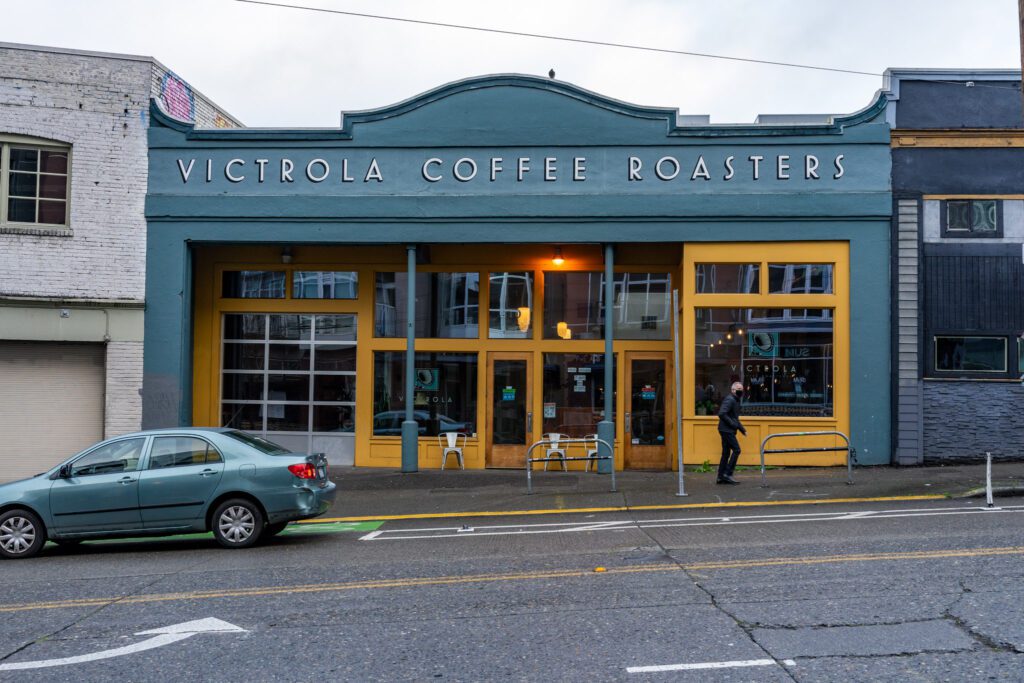
- Victrola: Victola is one of the OG’s in the Seattle coffee scene, and I really like both their location in downtown and their location in lower Capitol Hill, which is where they do their roasting (and host regular cuppings every Friday morning at 11am). The location a few blocks away from Pike Place Market is the place to go before you start this itinerary.
- Monorail Espresso: Another classic, Monorail Espresso has been a staple of the ever-changing Seattle coffee scene since 1980 (!). The espresso is king here (go elsewhere for filter coffee), and their location on Pike is your best bet because it’s open on weekends (some of their other downtown locations aren’t).
- Elm Coffee Roasters: The best specialty coffee of these three choices, I think, but also the furthest out of the way if you’re going to Pike Place Market. Elm is in Pioneer Square (they used to have a cafe in South Lake Union too), and is worth the journey. They have a bunch of interesting single origin coffees, and usually have at least one of them on filter and espresso to try.
Pike Place Market
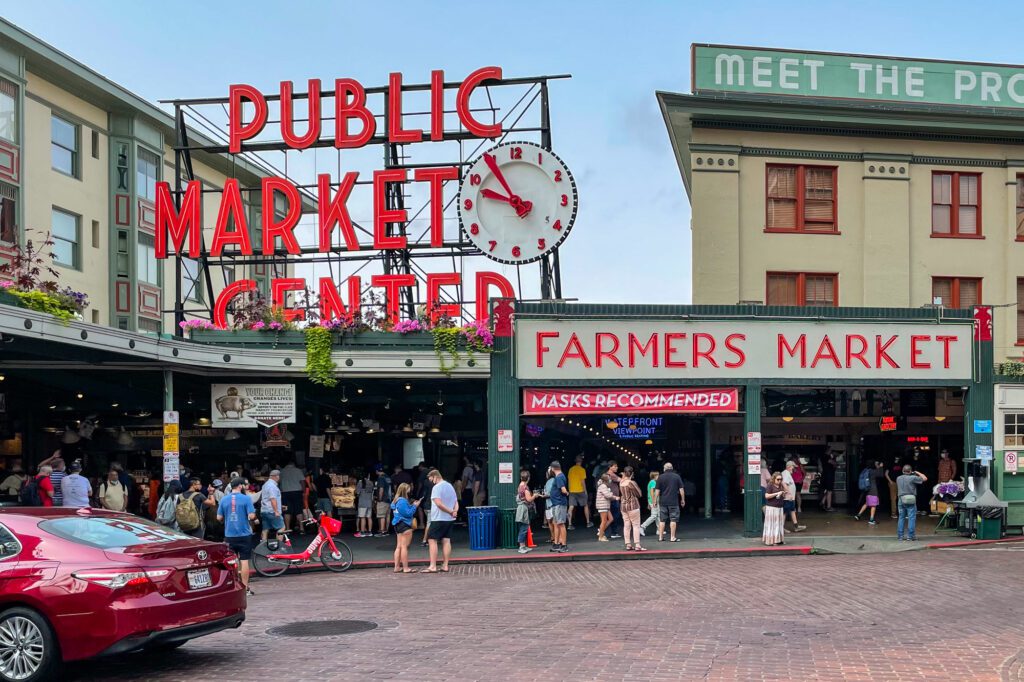
Take note y’all: it’s Pike Place Market – there’s no “s” (P.S. that’s how you can tell if someone is actually from the Seattle area or not as you’re reading other guides).
We struggle with the word “touristy,” which gets thrown around often as a pejorative for attractions like the Colosseum and Louvre. On one hand, yes, those places are packed with people at all hours of the day and can be kind of unpleasant at peak times.
On the other hand, we also think those places are 100% worth visiting, and it’s all about how you visit them.
That’s exactly how we feel about Pike Place Market. Is it “touristy?” Yes. Should you go to Pike Place Market? Also yes.
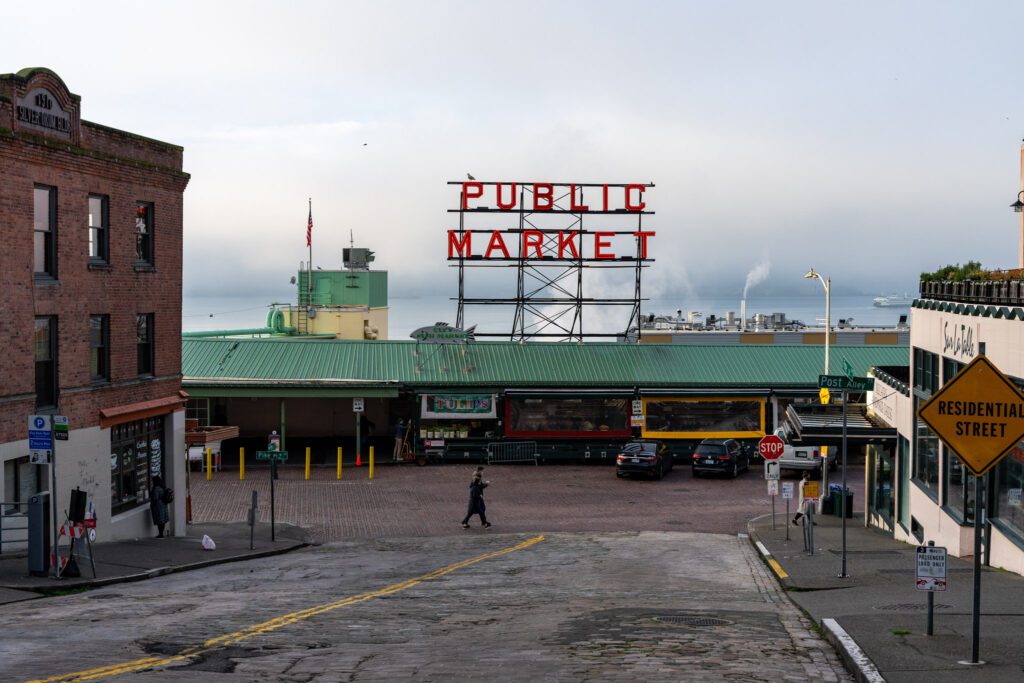
In our opinion, Pike Place Market is best in the morning, which is when you’ll find fewer people wandering around. On the other hand, you might not feel like tasting cheese or beer at 8am, so mid-morning it is!
Pike Place Market is full of energy, and you’ll find everything from fresh-caught oysters to amazing candied nuts, and even a wall full of gum. The Gum Wall is straight up gross. It’s literally people’s used chewing gum. Is that really where you want to take an Instagram photo?
Here are our favorite stops while you’re at Pike Place Market:
- The upstairs market area, with the fresh seafood stands (including the famous flying fish, which is worth watching) and flower vendors is worth meandering through.
- Ellenos Greek Yogurt: Exactly what it sounds like – amazing frozen Greek yogurt. Plus delicious toppings.
- Rachel’s Ginger Beer: Awesome ginger beer with all sorts of flavors. They also serve cocktails, which may or may not be good for your mid-morning visit, depending on what kind of weekend in Seattle you’re planning.
- Beecher’s Cheese: Their flagship cheese is fantastic – one of our favorites. Their cafe at Pike Place has all sorts of cheesy goodies. Get the mac & cheese if you can handle gluten.
- I’ve never actually been, because gluten, but Piroshky Piroshky is one of my brother’s favorite spots.
- The Alibi Room, which is just under Pike Place, is one of my favorite bars in Seattle, and was where I took Alysha on our first trip to Seattle so she could try the woodfired pizza (and I could drink my sorrow away at not being able to try it).
- Indi Chocolate: YUM. It’s really, really good chocolate. Do I really need to say anything else? They make it at Pike Place too!
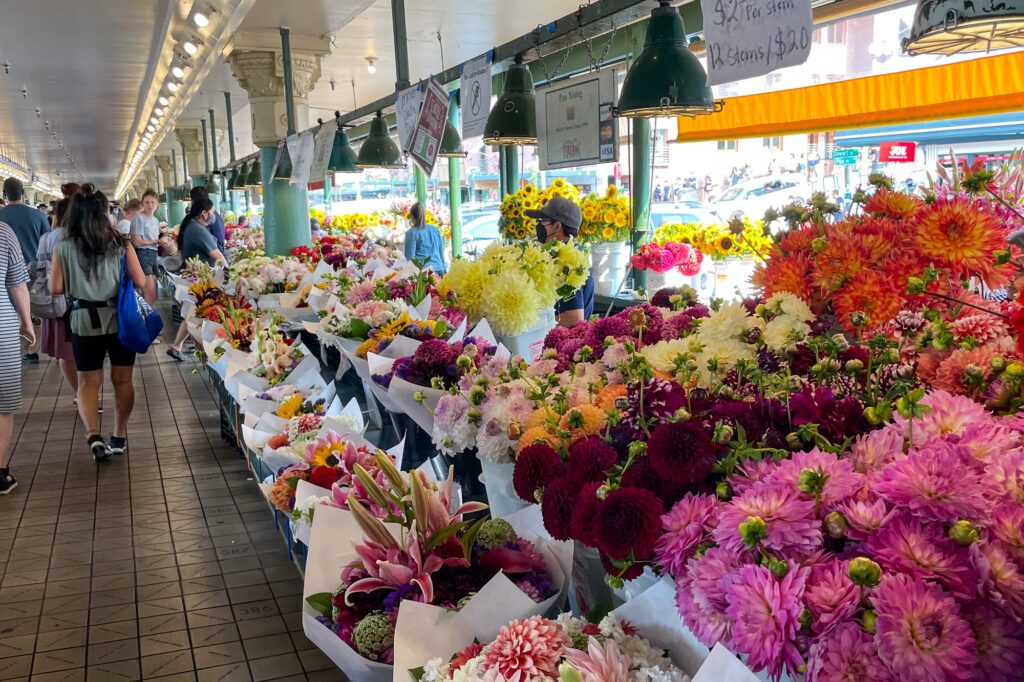

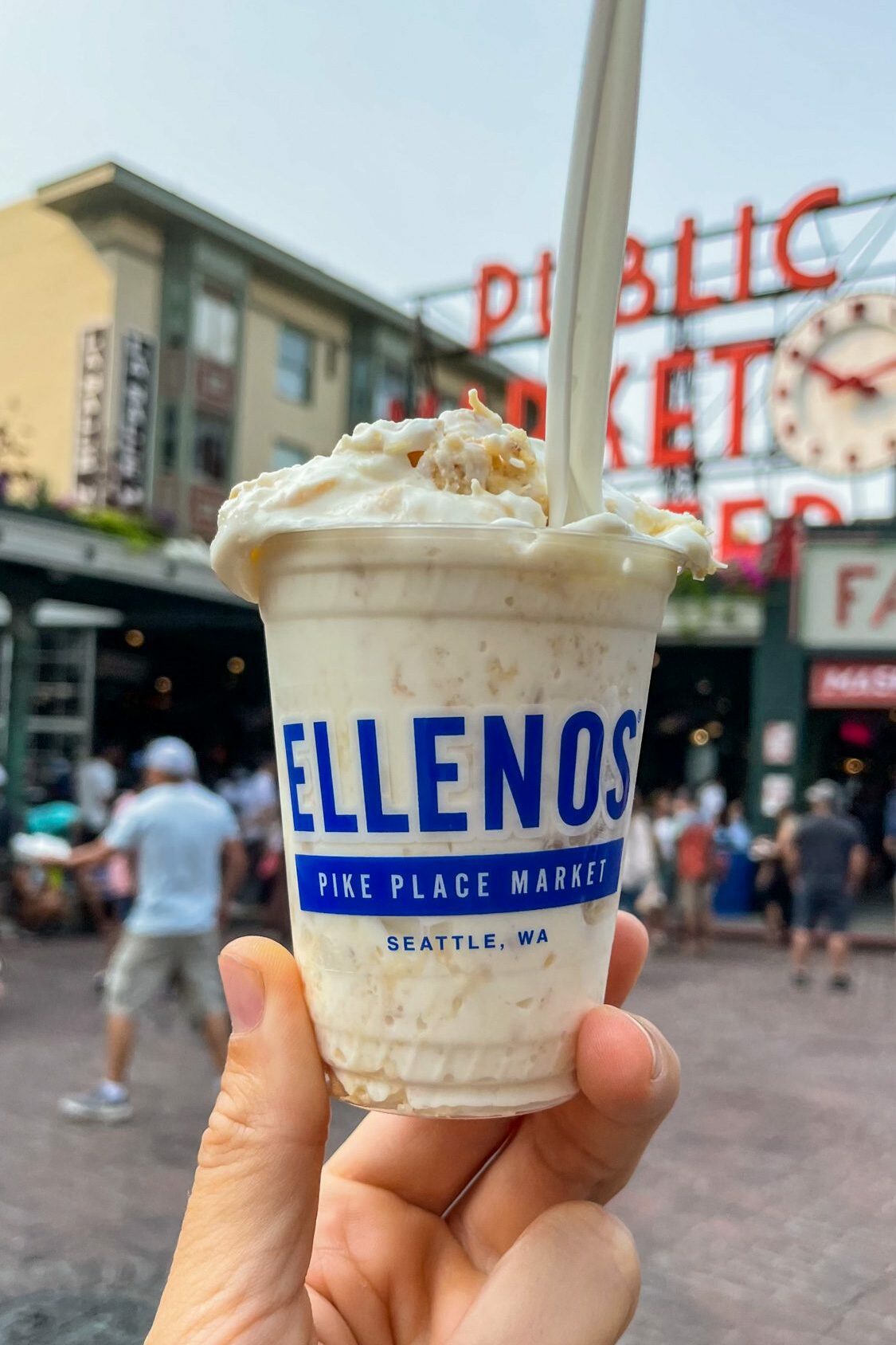
If you’re a foodie, I’d recommend investing in a guided tour of Pike Place to dive a little deeper into the history, and, more importantly, the best things to eat and drink.
My brother gave my mom this tour of Pike Place Market a few years back as a gift, and they really enjoyed it.
Both tours include enough food to be considered a light lunch, so come hungry! You’ll taste things like cheese, clam chowder, and more.
Walking the Seattle Waterfront and the Olympic Sculpture Park

Once you’ve had your fill at Pike Place Market, it’s time to walk to Seattle Center, which is the location of the iconic Space Needle, the most famous part of the Seattle skyline.
On the way, we’d recommend going a bit out of your way to walk along the Seattle waterfront (past the Seattle Aquarium and the Great Wheel, which we strongly recommend skipping) and then stopping at the Olympic Sculpture Park.

The Olympic Sculpture Park is a permanent art installation put on by the Seattle Art Museum that features a few giant red sculptures, which (on a clear day) are backed by the snow-covered Olympic Range in the distance. It’s a nice spot, and is worth the short detour.
Seattle Center
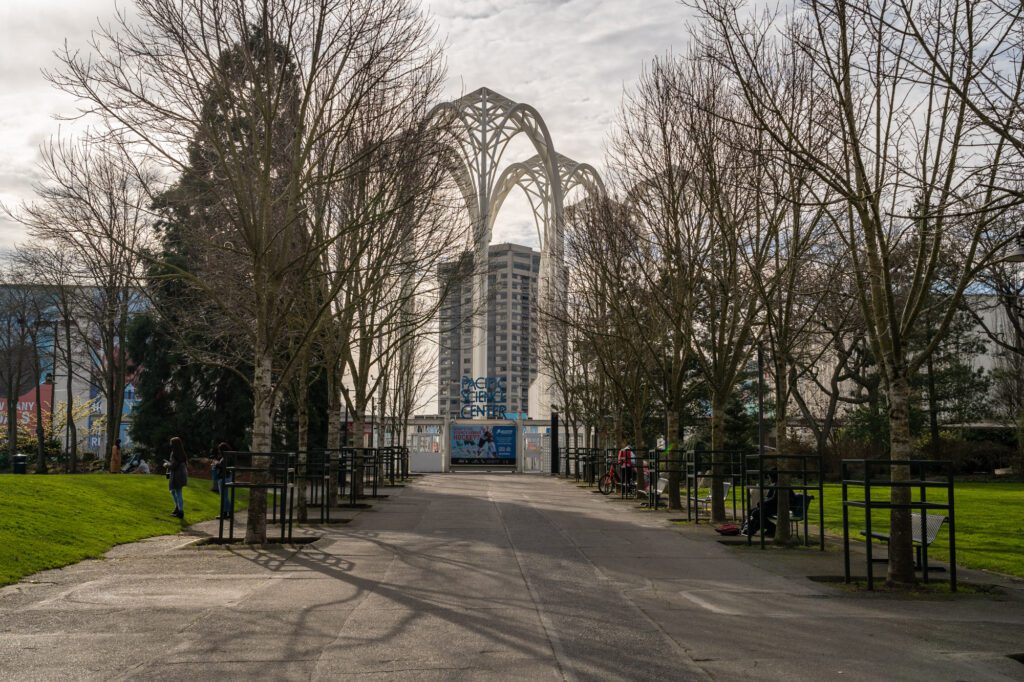
There’s a bunch of stuff to do and see at Seattle Center, but you’ll need to prioritize based on your interests.
With a short time in the city, we’d probably opt to spend your time by walking around the base of the Space Needle, visiting the International Fountain and Vita at KEXP for coffee, and then hitting one of the museums (we really like MoPop).
First, let’s talk about the Space Needle, which is the most distinctive landmark in Seattle.
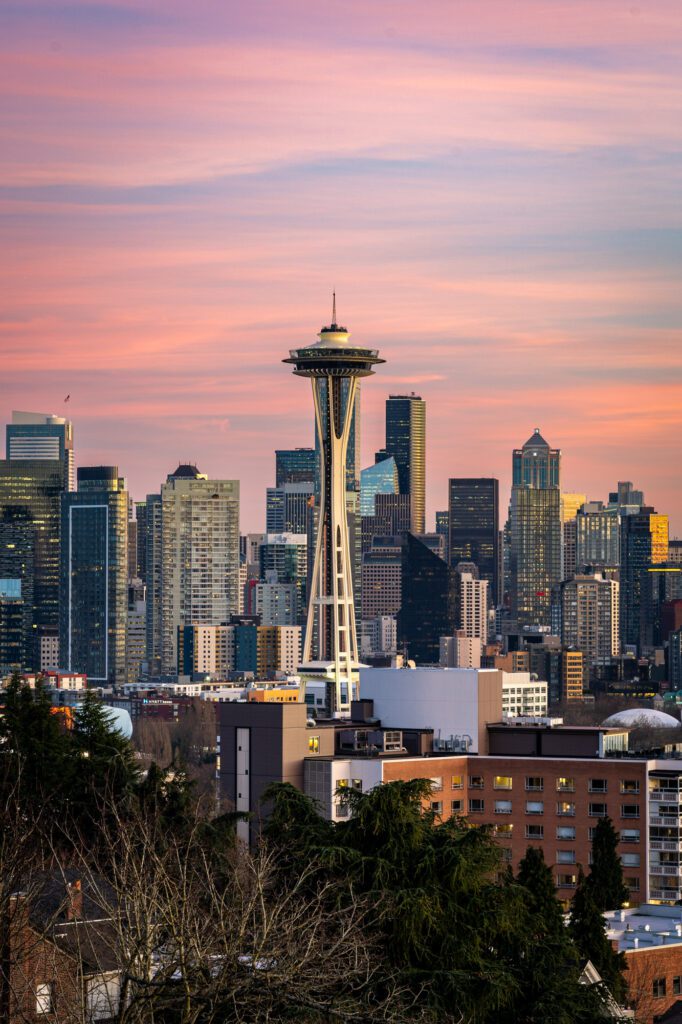
I (Matt) don’t think you should go to the top.
I’ve been to the top exactly once, and it was when I was a small kid and we were visiting Seattle to see if we wanted to move there from the Bay Area.
It’s really expensive, and there’s a better view (that includes the Space Needle) just up the street for free (we’ll get to that in a second, don’t worry).
Whatever you do, definitely do not eat at the restaurant on top, where the food is decidedly mediocre, at best, and very expensive. There are much better options for a special occasion (Canlis and Il Nido are the first ones that come to mind).
With that part out of the way, let’s talk about the other cool stuff at the Seattle Center.
It’s worth stopping by the International Fountain.
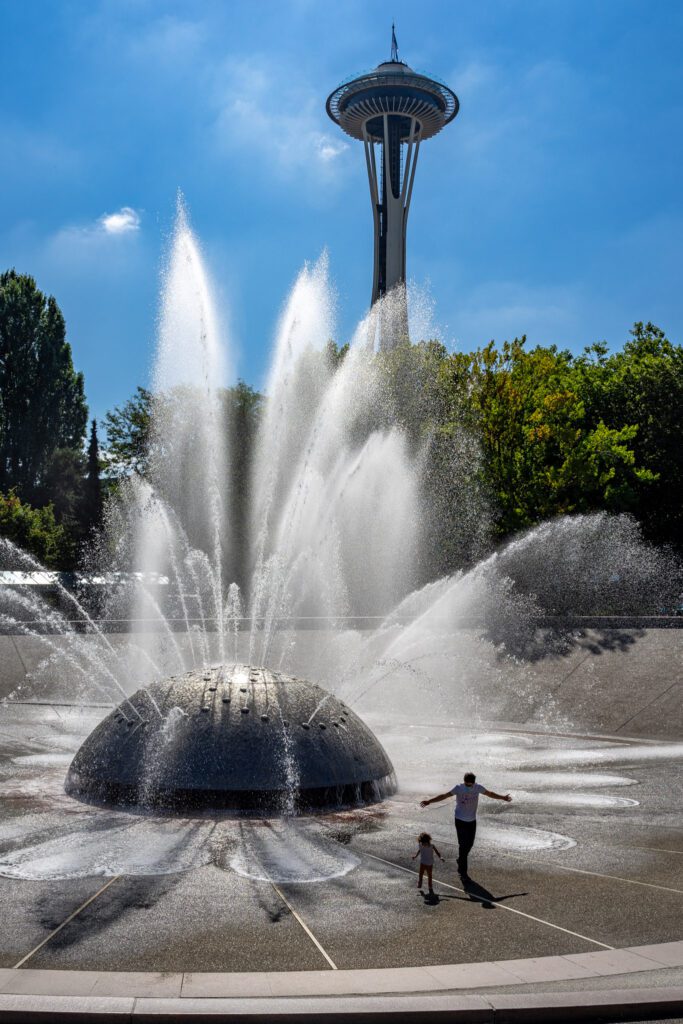
It’s a fun fountain that sprays water up in the air, often to a soundtrack. There’s plenty of seating along the rim, where you can watch the kids frolic in the water while they’re parents watch them closely. Good people watching here.
The other place to go that isn’t a museum is Vita at KEXP, which is one of my favorite coffee shops in Seattle.
It’s run by local roaster Caffe Vita, and they serve good coffee with a nice selection of both single origin beans and specialty drinks.

The main reason I like it is that the space is really cool – it’s a real life radio studio for KEXP, and it’s a high-ceilinged space that features imagery of Seattle’s music scene over the years. There’s even a record shop onsite to really bring home the Seattle vibes.
Now onto the museums you should check out at Seattle Center, depending on your timing and interests.
MoPop: This funny looking building of different shapes and colors is distinctive, not only for its exterior, but for what’s inside. It’s very much a different kind of museum than a lot of the other museums you’ve visited on your travels. It’s interactive, and focuses on all things pop culture (lots of music), and is a fun activity for all ages, including adults. Definitely my top pick out of the three attractions here, and my high school prom was here back when it was the EMP (Experience Music Project).
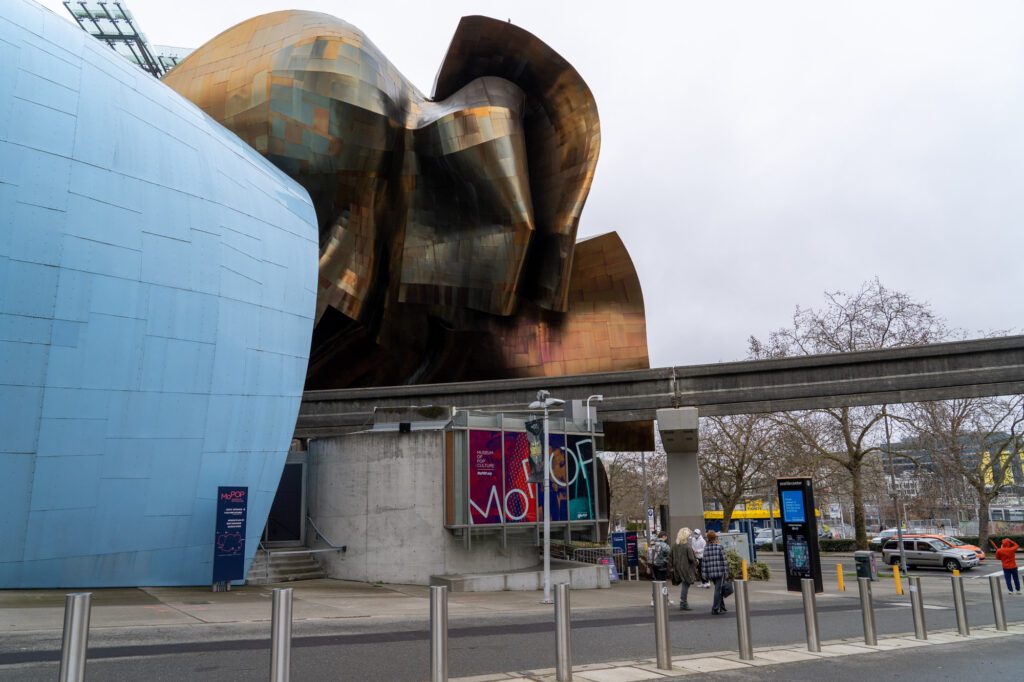

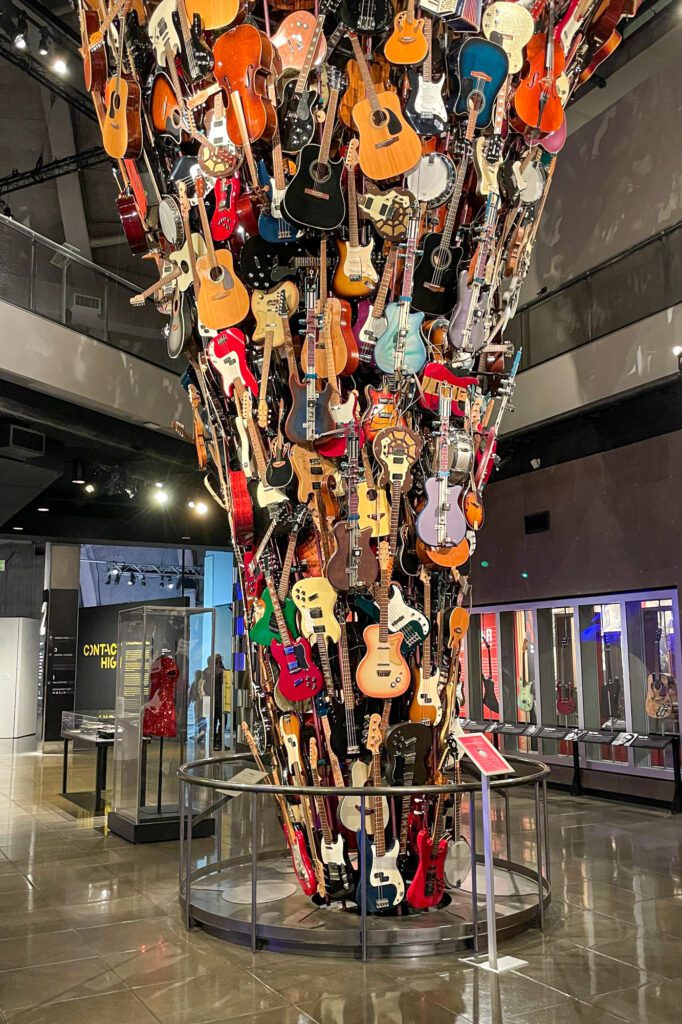
Chihuly Garden and Glass: This is a cool permanent art installation celebrating the work of Dale Chihuly. The Glasshouse, a gorgeous 4,500 square foot space full of natural light and home to a colorful 100 foot long sculpture of flowers hanging in the middle.
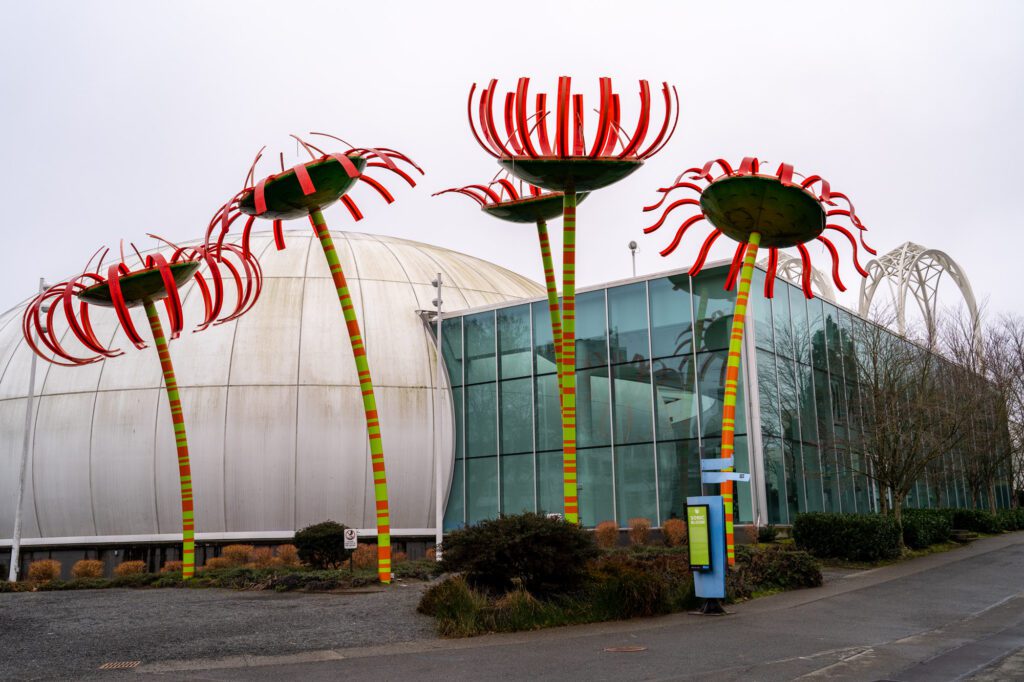
Pacific Science Center: This is an experience for kids. In elementary school, we used to come here for field trips. They have all kinds of hands-on exhibits, and it’s a perfect rainy day activity for families in Seattle. Adults, probably skip it.
Kerry Park
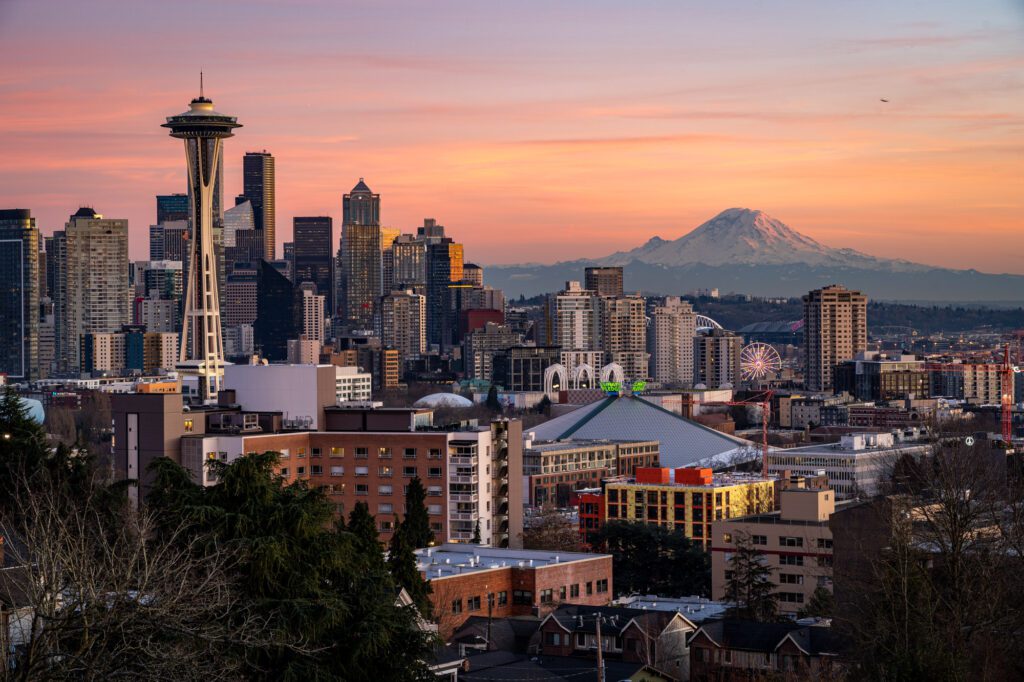
My number one tip for your visit to Seattle – and I tell this to everyone (real life and internet peeps) who will listen – is that you should skip going to the top of the Space Needle and head straight to Kerry Park.
Why? For the best views of the Seattle Skyline, including the Space Needle and a sweeping view out over Elliott Bay with Mount Rainier towering over the city (on a clear day, anyway).
The problem with going to the top of the Space Needle is that when you’re viewing the Seattle skyline from there, you’re missing what is probably the most iconic symbol of the city. Because you’re standing on top of it.
Once you’ve finished meandering your way around Seattle Center and the base of the Space Needle, head up Queen Anne Ave N, at the northwest corner of Seattle Center, and walk up the hill to Kerry Park. (Here’s a map)
This is where you’ll find that postcard-perfect great view of Seattle. You’ll have a view of the Space Needle in the foreground, backed by the Seattle skyline and, on a clear day, Mount Rainier poking its giant face out in the distance.
Plus, views over Puget Sound to the west.
It’s pretty spectacular, and is probably worth coming back at the end of the day for sunset (or waking up early for sunrise).
An Evening in Capitol Hill

Capitol Hill, which is east of Downtown Seattle on the other side of I-5 (which runs down the middle of the city, kind of like Portland), is our favorite neighborhood in Seattle.
It’s quirky, hip, central, and full of great places to eat and drink. We love it, and think you will too.
Spend your time in Capitol Hill exploring on foot. Start at the southwest corner, where you’ll find the Starbucks Reserve Roastery, and make your way northeast from there to around Cal Anderson Park. Here are some of our favorite spots along that route.
Whatever you do, definitely stop by Elliott Bay Book Company, which is our favorite independent bookstore in the city.
Here are some of our other favorite spots for dinner and drinks in Capitol Hill for an afternoon / evening trip.
To eat:
- Dick’s Drive In (Cheap Burgers): A Seattle OG and, arguably, one of Seattle’s icons, Dick’s is very simple. Affordable burgers, good fries and milkshakes, and no substitutions. It’s a popular late night spot.
- 8 oz Burger (Fancy Burgers): Higher end burgers with more innovative toppings and different meat options (including veggie). Great happy hour meal deals from 4-6pm and 9pm-close Monday to Friday where you can get a burger meal for $12-15 and beers for $6. When my cousin is in town, she demands to go here at least once.
- Kedai Makan (Malaysian): Malaysian food isn’t something you come across terribly often, especially in cities off of the west coast, so this is a fun spot to try something a little different. Make a reservation in advance, it’s a popular spot. We haven’t been here ourselves because it’s not good for Matt (who has Celiac Disease and needs to eat gluten free), but it would be top of our list if it were safe.
- Carmelo’s Tacos (Tacos): An unassuming taco truck with Mexico City-style tacos. And burritos (but we’re all about tacos). Here is their Cap Hill location on Google Maps.
- Molly Moon’s (Ice Cream): The OG Seattle ice cream shop with locations all over the Seattle area at this point. Their flavors range from the usual to funky, and they are another one of Seattle’s iconic can’t-miss spots.
- Frankie and Jo’s (Ice Cream): If dairy and/or gluten are an issue for you, Frankie and Jo’s is there for you! They’re a gluten free, plant-based ice cream shop with a location in Cap Hill. All of their ingredients are posted for transparency, and the cones are gluten free too (though if you’re a Celiac and avoid oats like Matt, many of their flavors and cones are off limits).
For drinks:
- Cocktails: Arguably, this is where Capitol Hill really shines on the drinks front. Some of Seattle’s best cocktails are shaken and stirred in Cap Hill. Tavern Law and Canon (the latter have 4,000+ spirits on hand, and a HUGE list of whiskeys available) are two of the best. Rumba, a rum focused bar on the edge of the neighborhood closer to downtown, and the reservations-only bar inside, Inside Passage, are also worth looking at, especially if (like Matt) your taste in cocktails skews towards the rum/tequila end of the spectrum.
- Wine: There are two solid wine bars a few blocks apart in eastern Capitol Hill. Otherworld is a cozy little wine bar and shop with a rotating cast of wines by the glass and bottle. Footprint is a wine bar focused on wines on tap, which is a more sustainable way to make wine than glass bottles.
- Cider: Did you know that something like 90% of the apples consumed in the US are grown right here in Washington State? Specifically over in eastern Washington near Wenatchee. There is only one choice for cider in Cap Hill, and it’s Capitol Cider (recently rebranded as A Stir?). They have 170 ciders between taps, bottles and cans.
- Beer: For a massive variety of different beers, mostly local, we like Chuck’s Hop Shop on Union (it’s called “Central District” on their website, if you’re confused). Outer Planet (they brew their own beer), Stumbling Monk (they focus on Belgians), and the Elysian Brew Pub (their original location) are also all good options.
Day 2: Discovery Park, Ballard, and Fremont
On your second day, spend some time in the northern part of the city, which is where you’ll find our favorite hike in Seattle and two of our favorite neighborhoods in the city.
Note that if you’re in Seattle on a Sunday, you should make sure this is Sunday so that you can hit the excellent Ballard Farmers Market, which we’d call a must-do in Seattle.
This day is definitely less convenient in terms of getting around, but there are some helpful bus lines that will connect the downtown core to Fremont and Ballard (and back); route 33 runs from downtown up to Discovery Park, route 40 runs between Fremont and Ballard and Downtown, and the D line is an express bus that connects Downtown and Ballard.
A Morning Hike in Discovery Park
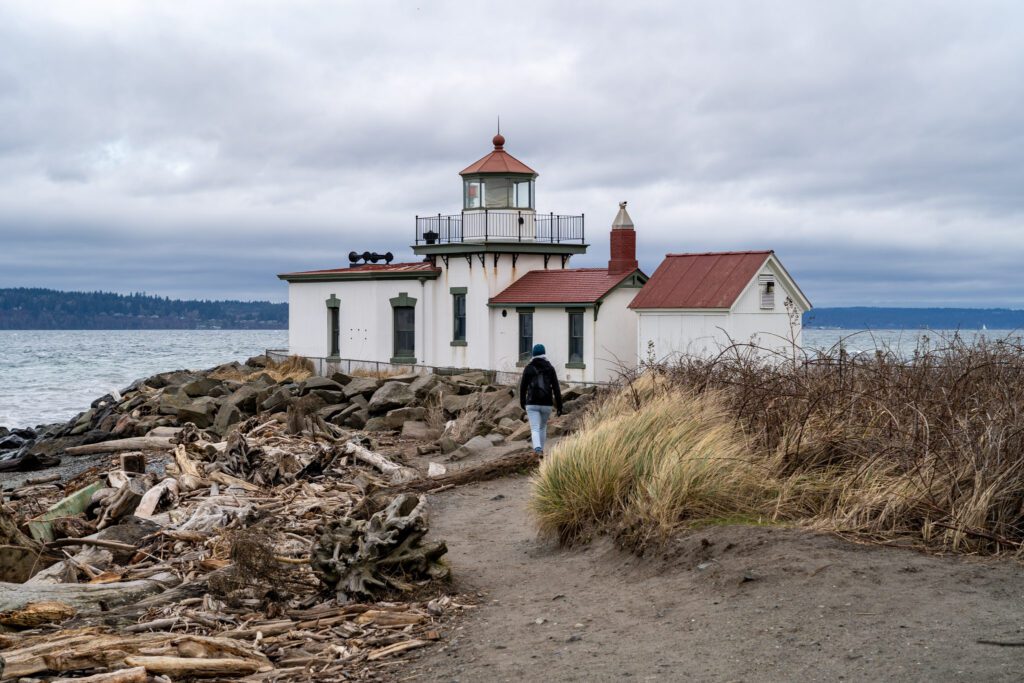
Discovery Park is a huge park – the biggest in Seattle, in fact – on the northwest side of the city. Sitting on the Puget Sound, the highlight of the park (we think) is the trail down to the beach and the West Point Lighthouse.
We called this a hike in the description of today’s activities above, but it’s really more of a nice, easy walk. There’s a little bit of up and down, but it’s a pretty easy “hike” on the whole.
Along the way, you’ll walk through dense forest full of mossy, ferny undergrowth that is peak Pacific Northwest, traverse some bluffs with great views of the Puget Sound, and end at the Lighthouse where you might see the resident bald eagles hanging out on the antennae (or in the tops of the trees).

In terms of getting between Discovery Park and your next stop, Ballard, we’d recommend walking across the Ballard Locks, which is the place where salmon travel upriver during the summer. There’s a cool exhibit about salmon in the visitor center on the north side of the canal, too.
That means that you’ll want to end your walk at the northern end of the park (head for this parking lot) to put yourself in position for getting to Ballard.
This is the route we’d follow, which starts at the south parking lot, heads out to the Lighthouse, and then follows a path along the beach before ending with a brief climb through the forest to get to that north parking area.
From there, it’s an easy walk to the Ballard Locks, or a Lyft to Ballard itself.
Ballard
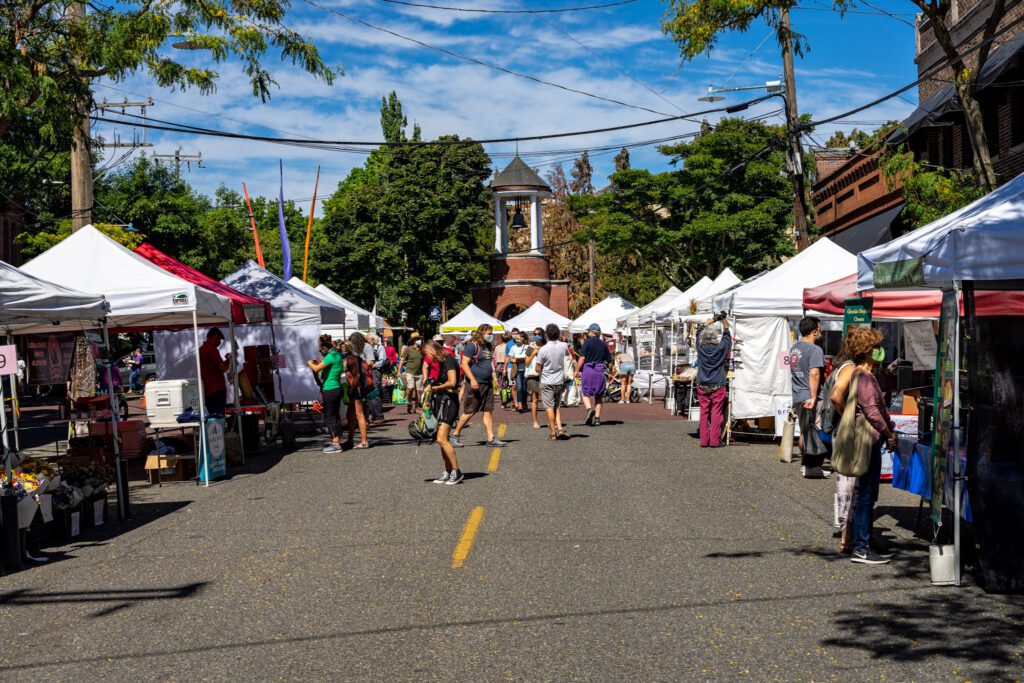
With Fremont, Ballard forms the northwestern edge of Seattle’s city center (we’d call the more residential neighborhoods to the north outside of the city center).
It runs along the ship canal, which connects Seattle’s lakes to the Puget Sound, and that canal was essential for Ballard’s economy in the past, when it was known for industry and fishing and canning.
At one point, Ballard was an independent city, but Seattle’s growth swallowed it up in 1907 and it has become one of the most desirable places to live in Seattle.
That history as an independent city gives it a very “city within a city” vibe, which we like. It’s far enough out to be quieter and more low-key than the downtown core (which makes it a bad place to base yourself), but has plenty to do, see, eat, and drink to keep you busy.
We mentioned this above, but if you are in Seattle on a Sunday, you absolutely should not miss the Ballard Farmers Market, which is our favorite market in Seattle.
There are stalls from local farms, ready-to-eat foods, and other local small businesses selling pottery, hot sauce, cider, and more.
Here are some of our other favorite spots in Ballard in no particular order.
- Root (Coffee + Plants): If you like light roast coffee, this is the best place in Seattle for you to come. They have a rotating selection of some of the best roasters in the US – like Sey and Ilse – along with a few international treats.
- Venue: An art gallery featuring work from local artists, including Red Umbrella Designs, one of our favorite Seattle artists.
- Mox Boarding House: We have one of these down in Portland, and it’s a really good time for a drizzly afternoon. Cozy space with every board game under the sun.
- La Carta De Oaxaca: Good Oaxacan food right in the heart of all the action. Mexican food is so diverse, and this is a good spot to experience the magic of Oaxacan food, with fresh masa served in all shapes and sizes.
One other recommendation would be the industrial area east of Ballard, which is where some of Seattle’s best breweries are found.
Stoup Brewing, Reuben’s Brews, and Yonder Cider / Bale Breaker Brewing are all within a few blocks of each other, and make for a good brewery crawl, if that’s what you’re into.
Gas Works Park
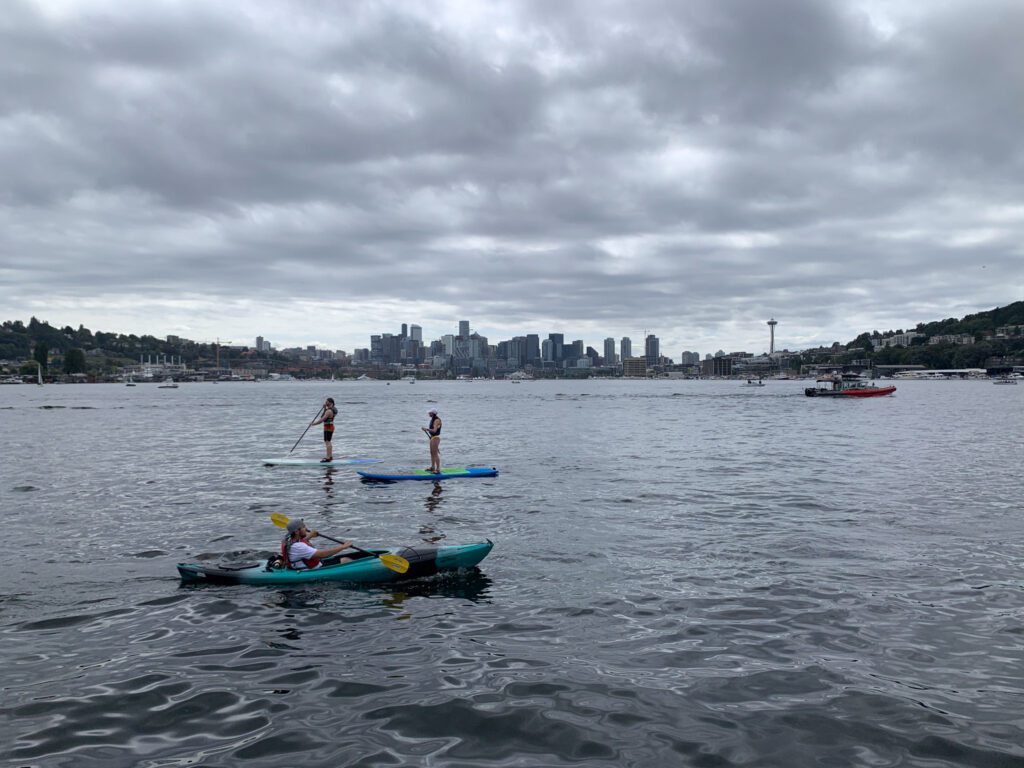
Gas Works is a bit of a detour from Fremont itself – it’s on the opposite side of Fremont if you’re coming from Ballard – but we think it’s worth it on a nice evening for the great view of the Seattle skyline across Lake Union.
To get there, you can hop on the bus (route 40) in Ballard and then walk along the Burke Gillman trail, which is a very popular trail for runners and cyclists in Seattle. Here’s the map.
The first thing you’ll notice when you arrive at Gas Works is the remains of the gas plant that give the park its name.
The big, rust-colored buildings are a look-don’t-touch situation for the most part, but you can walk into the buildings that have been renovated and learn about the history of the location.
Like we said, the highlight here is the view of Seattle across the water. To get that postcard view, head up the grassy hill in the middle of the park.
Fremont
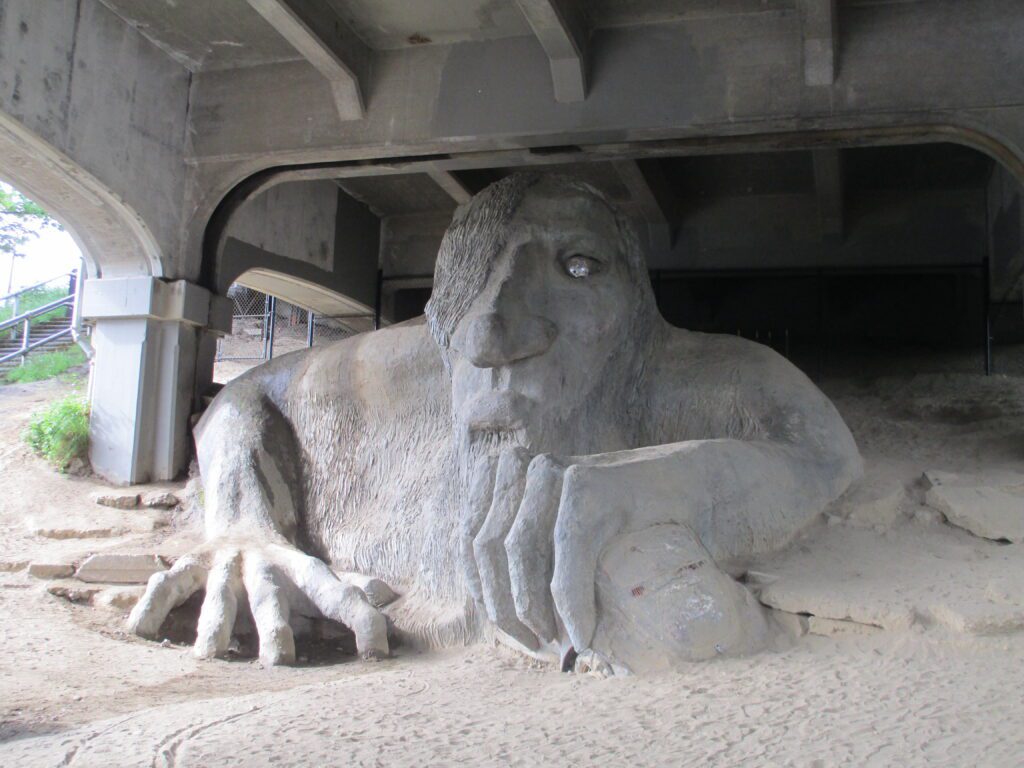
Fremont is a fitting spot to end your trip because it’s the best food neighborhood in the city, we think, which means you’re ending on a high note. It’s one of the neighborhoods, along with Cap Hill and Ballard, that we continually find ourselves visiting whenever we’re in Seattle.
Fremont is on the northern side of Lake Union, and the core is very walkable and relatively compact (though a few of the spots below will require a bit of a walk). From that core, it gets very residential, very quickly.
The most famous spot in Fremont is probably the Fremont Troll, which is a troll sculpture under the Aurora Bridge that has become a famous tourist destination over the years. Here’s a good read about the history of the troll.
After Gasworks, it’s likely getting toward the end of the day, and Fremont is a great place to close out your day with dinner and drinks.
Here are a few of our favorite spots in Fremont.
To eat:
- Ester’s Enoteca (Italian/Spanish): This unassuming spot right on Fremont Ave is our go-to spot to get food to take to Schilling. They have gluten free options for most of the menu (which is why we like it), which takes inspiration from some combination of Spain and Italy.
- Lupo (Pizza): The first of two great pizza options in Fremont, this is all about the sourdough, wood-fired crust. Make a reservation if it’s a weekend.
- My Friend Derek’s (Pizza): Self-proclaimed “pretty good” Detroit-style pizza. Take out only, and it’s a tiny place so their hours are wonky – make sure to check to see when they’re open.
- Joule / Revel (Korean-inspired): Owned by two James Beard nominees (in 2022) who happen to be partners, these two sister restaurants are both in Fremont, and are both worth getting a reservation at if you’re looking for a nice dinner spot to close out your trip.
- Kamonegi (Japanese): Run by another James Beard finalist in 2022, Mutsuko Soma, this spot just outside of Fremont’s main strip is all about the handmade soba noodles.
- Made in House (Korean): A little more casual than the restaurants above, this is a nice spot for a late lunch because they do close at 4pm. They’re known for their Bibimbop and Bento (which is essentially a sampler). If there are two of you, we’d order both and share them!
For drinks:
- Brouwer’s Cafe (Beer Bar): Cozy, candlelit, kind of romantic. They’re primarily a beer bar with a slant towards Belgian beers, but have a good cider and whiskey selection too.
- Schilling Cider (Cider Bar): They have 35+ ciders on tap, and even more in bottles. The thing we like about going to Schilling is that it’s not just their own ciders – they also have ciders from around the Pacific Northwest and even a few international ciders to try. Plus board games and they’re dog-friendly. No food, but you can bring your own.
- Imperfetta (Wine Bar): Primarily a retail shop, but they also have a few bottles open for glass pours most nights. No kids allowed at any time (21+).
What to Do with More Time in Seattle
Here are a few ideas for things to add with more time in Seattle.
Ride the Ferry to Bainbridge Island and Back
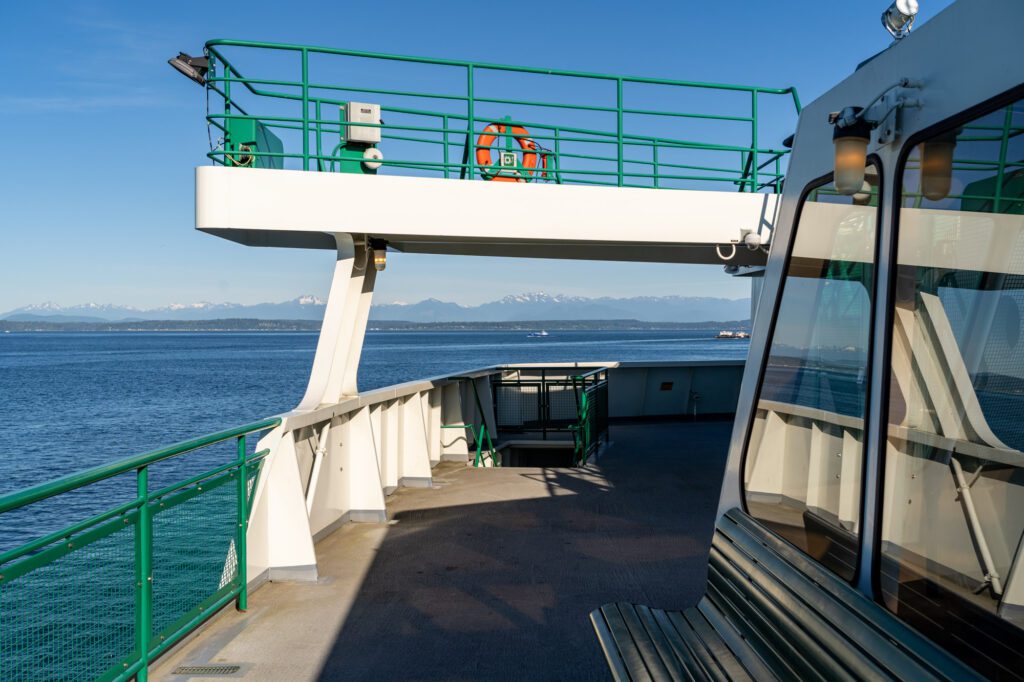
This is the first thing we’d add, especially if it’s a nice day.
The ferry ride is roughly 60 percent of the fun of going out to Bainbridge, which you can absolutely do even if you don’t have a car (bonus: you don’t have to wait in the car line for the ferry on the way there or back, you can just walk on).
Don’t miss Proper Fish for excellent fish and chips served in newspaper with mushy peas (this is the way) and Blackbird Bakery.


We like this option so much we have an entire guide dedicated to planning a day trip from Seattle to Bainbridge Island.
Learn About Seattle’s History at MOHAI

The long acronym stands for the “Museum of History and Industry” and the museum is right on the shores of Lake Union.
On a rainy day (there are plenty of them in Seattle) this is a great place to go spend a few hours learning about Seattle’s history as a gold rush town and then a tech hub (which are sort of similar in their effects on the city’s trajectory, when you think about it).
Sitting in the shadows of the numerous Amazon skyscrapers in SLU is probably a fitting location for a museum about Seattle’s meteoric rise, we think.
Take a Day Trip to Mount Rainier National Park
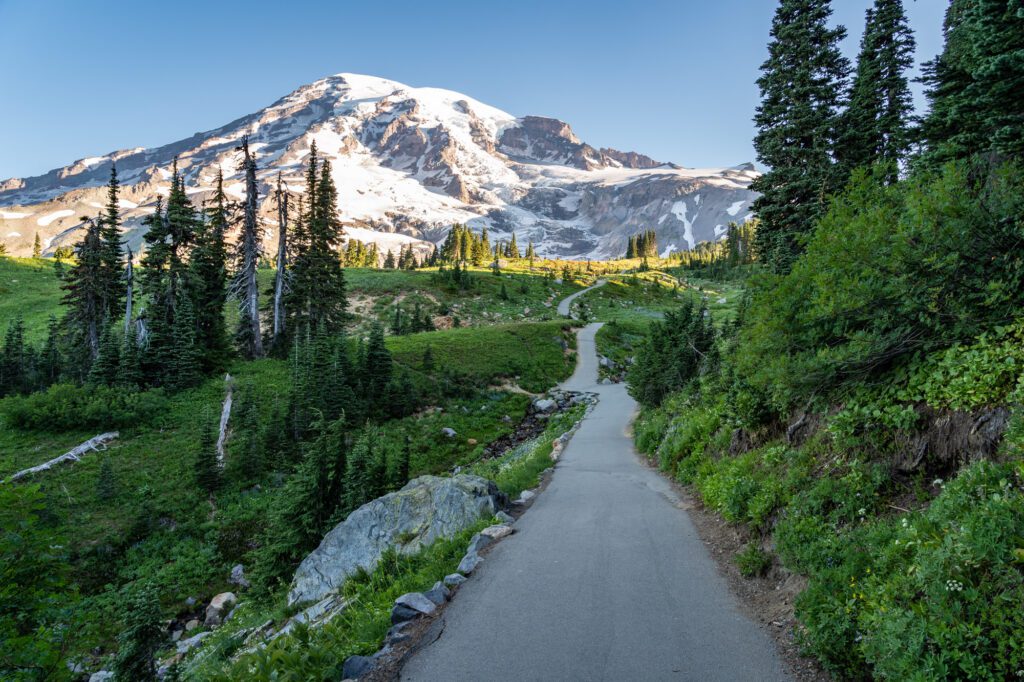
Mount Rainier is one of our favorite places in Washington State, and though it’s a long day, it’s doable as a day trip from Seattle (even without a car).
The thing that makes Rainier impressive is that it’s a huge mountain surrounded by land that’s at sea level, which makes it all the more imposing.
The only way to do it without a car is to take a guided day trip (we’d choose this small group hiking/snowshoeing tour), which means you don’t have to rent a car, but you’re relatively limited in what you’ll get to do and see.
If you do want to rent a car, we have an entire guide dedicated to planning a day trip to Mount Rainier.
What to Do with Less Than 2 Days in Seattle
If you have 24 hours, we’d essentially do the first day of this itinerary as written.
Another option would be to swap Capitol Hill for Fremont (or Ballard), depending on what you’re interested in, but using the combo of Pike Place + Seattle Center as an anchor for your morning is the right approach, we think.
We also have an entire separate guide to spending one day in Seattle, which basically covers that idea in more detail.
